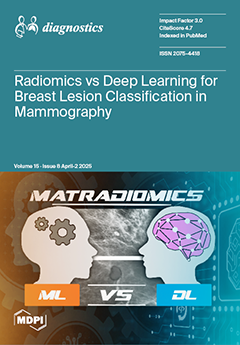Background: This study investigated PD-L1 and EZH2 immunoexpressions in endometrial carcinomas (ECs) and correlated their associations with clinicopathological parameters and five-year survival outcomes.
Methods: A cross-sectional, retrospective study was conducted on all ECs diagnosed between January 2014 and December 2018. Immunohistochemical staining for PD-L1 (clone 22C3) and EZH2 was performed on tumour samples, and their expression levels were assessed.
Results: Among the 104 EC cases included, 19.2% (
n = 20) overexpressed PD-L1, while 8.7% (
n = 9) overexpressed EZH2. Most (
n = 19/20, 95.0%) PD-L1-expressing tumour cells showed EZH2 immunonegativity. Likewise, most (
n = 8/9, 88.9%) EZH2-expressing ECs were PD-L1-negative. Increased PD-L1 and EZH2 expressions in ECs were seen more frequently in women more than 60 years of age (
p = 0.013 and
p = 0.039). EZH2 overexpression was associated with higher tumour grade (
p = 0.009) and more aggressive histological subtypes (
p = 0.013), while PD-L1 expression was not significantly associated with tumour grade, tumour stage, histological subtypes, and lymph node status (
p > 0.05). Kaplan–Meier survival analysis revealed that PD-L1-positive ECs had a significantly better five-year overall survival (OS) rate compared to PD-L1-negative ECs (
p = 0.034). Conversely, EZH2 overexpression did not correlate with survival outcomes (
p > 0.05). Notably, the combination of PD-L1 and EZH2 expression patterns on ECs (PD-L1-/EZH2+) portends the worst OS compared to other combined PD-L1/EZH2 expression patterns (
p = 0.05).
Conclusions: PD-L1 immunoexpression was associated with better survival outcomes in ECs, while overexpression of EZH2 was associated with higher tumour grade and aggressive histological subtypes, suggesting their potential utility as prognostic biomarkers in ECs.
Full article






